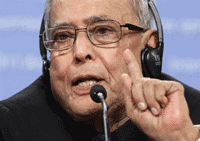
India's exports fall for the first time since 2009
New Delhi, May 1, 2012
India's exports in March fell for the first time since the 2009 global financial crisis as demand weakened in the United States and Europe, further clouding the outlook for the country's balance of payments.
Exports fell 5.7 per cent to $28.7 billion from the same period a year earlier, continuing a sharp slowdown in shipments in recent months that, combined with high imports of oil and gold, has sparked concern over the country's swelling trade deficit.
The export drop is the latest bad news for India's faltering economy. Ratings agency Standard & Poor's cut its credit rating outlook for India to negative last week, reflecting investor concerns about hefty fiscal and current account deficits and political paralysis that has put a brake on economic reforms.
India beat the government's target of about 20 percent export growth for the full fiscal year in 2011/12, which ended in March.
But Trade Secretary Rahul Khullar warned in January that exporters in Asia's third-largest economy faced a "difficult year", pointing to economic and financial weakness in the European Union, India's largest trade partner.
"The contraction in exports is worrisome," said Anubhuti Sahay, an economist at Standard Chartered bank in Mumbai.
"We still need to see if the contraction is just a temporary blip or not. It is not surprising, though, because if you talk about the main trading partners in Europe, there is a slowdown there."
India's balance of payments slipped into negative territory for the first time in three years in the three months through December on shrinking dollar inflows.
The current account deficit was $19.6 billion in the December quarter, higher than $9.7 billion a year earlier.
Rising global oil prices pushed up import bills for the country, which buys more than 80 per cent of its oil from overseas.
The deterioration in the current account deficit is expected to pile pressure on the rupee, which fell nearly 16 per cent against the US dollar in 2011.
The rupee recovered somewhat early this year, but has lost around 6 per cent since February as foreign investment dried up, highlighting its reliance on volatile capital inflows.
Prime Minister Manmohan Singh's government has been hit by months of criticism over corruption scandals and the wobbling economy.
Mark Mobius, one of the world's best-known emerging market investors, was the latest to criticise New Delhi for "many, many big policy mistakes". In an interview with Reuters on Tuesday, he singled out controversial tax reform proposals that would hit international firms.
India's imports rose 24.3 per cent to $42.6 billion in March, government data showed on Tuesday. Oil imports rose 32.5 per cent to $15.8 billion. The trade deficit was $13.9 billion.
India's exports rose an annual 21 per cent to $303.7 billion for the fiscal year 2011/12, while imports rose 32.2 per cent to $488.6 billion, figures released by the trade ministry also showed. The trade deficit for the full fiscal year was $184.9 billion. – Reuters







